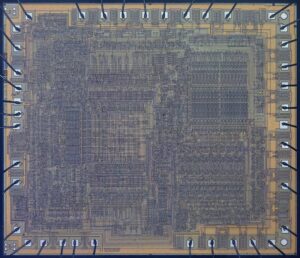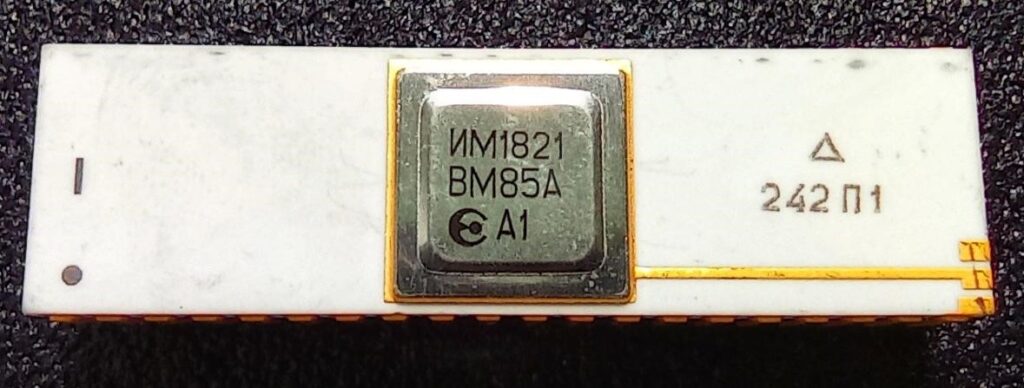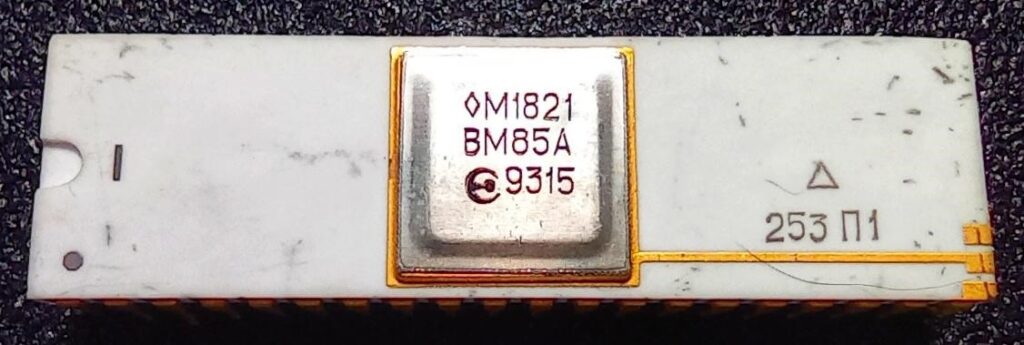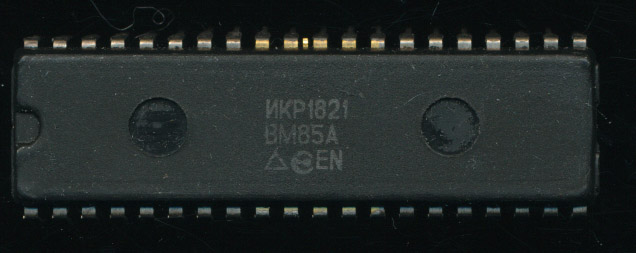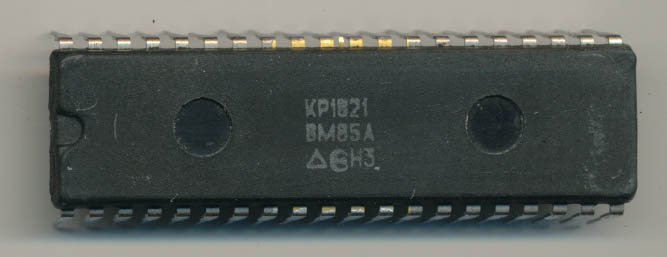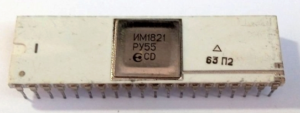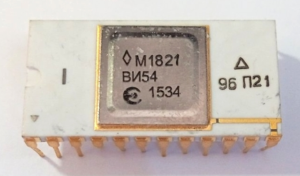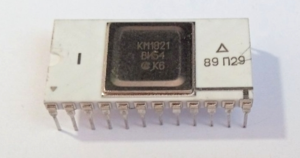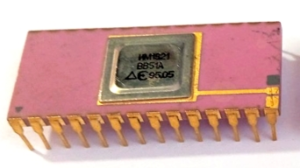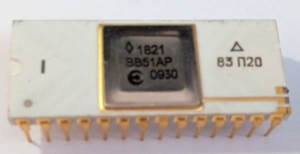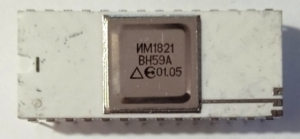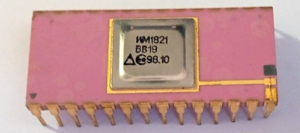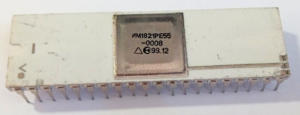The Soviet CMOS 8085 CPU: 1821VM85A
Omitting the history of the creation of the first microprocessors (such as the 4004) , let’s turn to the moment when 8-bit microprocessors (Intel 8080 and 8085, Motorola 6800 and Zilog Z80 ) firmly conquered the market. It was the time of the second half of the seventies in the last century. It became obvious to specialists that the future belongs to microprocessors, and if you do not invest in these technologies, you will simply fall out of the number of the developed countries. This was well understood by the advisers to the leaders of the USSR at that time. But they also understood that, since the countries of the Eastern Bloc were somewhat late in this work from US, it would be wise to copy the microprocessors already developed overseas. After all, these microprocessors have already solved many of those problems that would take months and years to solve on their own, not to mention huge monetary costs. (It should be noted that the Soviet Union had its own original developments. For example, the 587 series microprocessor kit, this included three microcircuits.)
| 587IK1 | 587IK2 | 587IK3 |
 |
 |
 |
At that time, it was not clear which chip needed to be copied – Intel, Motorola or Zilog. Each of them was good in its own way, and it was impossible to predict the outcome of the competition between them. In the end, it was decided to copy all microprocessors. And in order not to scatter forces, the enterprises of the USSR were entrusted with copying Intel products. Little Bulgaria got Motorola and Zilog chips were copied in East Germany. This is how Intel, without investing a single dollar, conquered the Soviet market. Microprocessors and microcontrollers under the names 580IK80A (8080A), 1821VM85A (80C85A), 1816VE48 (8048), 1816VE51 (8051) became native to Soviet electronic engineers.
The hero of this article is the 1821VM85A-8 bit microprocessor, a functional analogue of Intel 8085A (but in CMOS). It has been developed since the beginning of the 80s at the Novosibirsk plant of semiconductor devices. Production began in 1985. According to Wikipedia, the manufacturing technology is CMOS, 3 microns. According to other sources 0.7 microns, silicone-on-sapphire. Clock frequency – 5 MHz. Theoretically, it can work at a higher frequency.
The die contains about 6500 transistors. When copying the 80C85, several schematic and topological errors were corrected. As a result, the analogue saves stored data without a minimum clock, but the original does not. This manifests itself when the clock frequency changes. When it is reduced to zero, the microprocessor falls asleep, but the contents of all registers remain unchanged. When clocking resumes, the microprocessor continues to execute the program from where it left off.
It was produced in both ceramic and plastic 40-pin DIP packages.
At the beginning of the marking of microprocessors, the letters I (И), K, M could be used. I did not succeed in finding out the meaning of the letter I (И) in the marking. Sometimes the letter A is missing from the microprocessor name. The letter I (И) is often present in the marking of the chips of the Novosibirsk plant of semiconductor devices. Here is an example of a microcontroller from this manufacturer.
Marking the production date on chips was done in two ways. The first is the usual one, consisting of four digits. The first two digits are the year of manufacture, the second two digits are the week of that year. The second marking method corresponds to this table.
| Year | Code | Year | Code | Month | Code |
| 1986 | U | 2001 | N | January | 1 |
| 1987 | V | 2002 | P | February | 2 |
| 1988 | W | 2003 | R | March | 3 |
| 1989 | X | 2004 | S | April | 4 |
| 1990 | A | 2005 | T | May | 5 |
| 1991 | B | 2006 | U | June | 6 |
| 1992 | C | 2007 | V | July | 7 |
| 1993 | D | 2008 | W | August | 8 |
| 1994 | E | 2009 | X | September | 9 |
| 1995 | F | 2010 | A | October | 0 |
| 1996 | H | 2011 | B | November | N |
| 1997 | I | 2012 | C | December | D |
| 1998 | K | 2013 | D | ||
| 1999 | L | 2014 | E | ||
| 2000 | M | 2015 | F | ||
The 1821VM85A is the main component of the 1821 microprocessor kit. The kit includes:
1821RU55 – 2K CMOS STATIC RAM with I/O PORTS/TIMER
256 Words x 8-bits RAM
Two 8-bit Programmable I/O Ports
14-bit Programmable Binary Counter/Timer
Multiplexed Address/Data Bus
Direct Interface with 1821VM85A
Analogue of the i81C55
1821VI54 – CMOS PROGAMMABLE INTERVAL TIMER
Three Independent 16-bit Counters
Six Programmable Counter Modes
Binary or BCD Counting
Analogue of the i82C54
1821VV51A – UNIVERSAL SYNCHRONOUS ASYNCHRONOUS RECEIVER TRASMITTER (USART)
Synchronous communication upto 64 Kbaud
Asynchronous communication upto 38.4 Kbaud
Error detection (parity, overrun and framing)
Analogue of the i82C51A
1821VN59A – CMOS PRIORITY INTERRUPT CONTROLLER
Eight-Level Priority Controller, Expandable to 64 Levels
Programmable Interrupt Modes
Individual Request Mask Capability
Analogue of the i82C59
1821VV19 – MULTIBUS CONTROLLER
Analogue of the i82C19
1821VT57 – PROGRAMMABLE DMA CONTROLLER
4-Channel DMA
Priority DMA Request Logic
Channel Inhibit Logic
CMOS analogue of the i8257
All these microcircuits are still produced in a military grade versions.
Chips included in the kit, which are currently discontinued:
1821RE55 – 16K bit ROM WITH I/O PORTS
2048 Words x 8 Bits ROM (Mask Programmable)
Two General Purpose 8-bit I/O Ports
Multiplexed Address/Data Bus
Analogue of the i83C55
Initially, the microprocessor 1821VM85A was developed for a specific military product. In light of recent events, I won’t name it. Moreover, the microprocessor kit is still being produced, which means it’s in demand.
It was also planned to use 1821VM85 in the equipment of the An-71 aircraft.
The Antonov An-71 (NATO reporting name: Madcap) was a Soviet AWACS aircraft intended for use with VVS-FA (Fighter Bomber) forces of the Soviet Air Force. Only three prototypes were built before the program was canceled.
 The use of this microprocessor was not limited to the military sphere. The radio station RS-46M is designed for use in linear radio communication networks for communication with locomotive drivers. The microprocessor controller based on 1821VM85A was intended to control the radio station according to the program stored in it. It also served for communication with external computer.
The use of this microprocessor was not limited to the military sphere. The radio station RS-46M is designed for use in linear radio communication networks for communication with locomotive drivers. The microprocessor controller based on 1821VM85A was intended to control the radio station according to the program stored in it. It also served for communication with external computer.
I’m thankful to Andrey Perfiliev (Andrey_cpu) for his help in writing this article.
Photos of microcircuits are partially taken from Andrey_cpu and matrixplus collections.
Other photos are from the author’s own collection.
Written by Vlad
Edited and some photos by CPU Shack.


